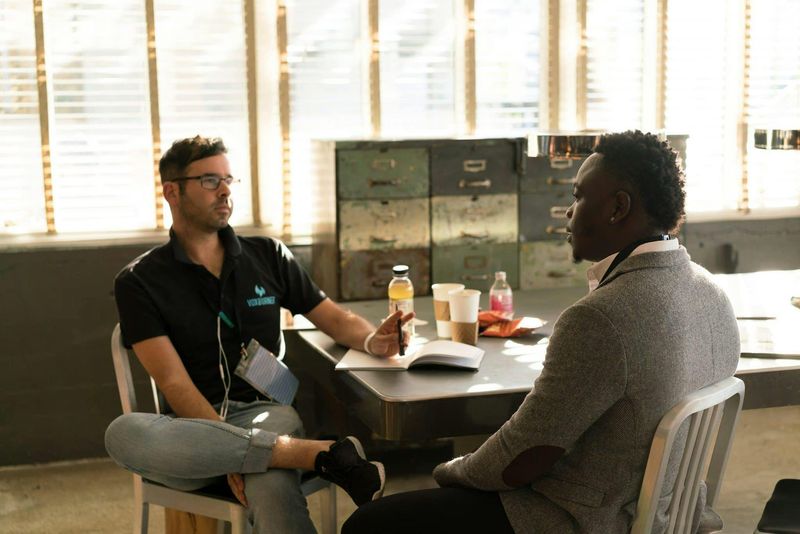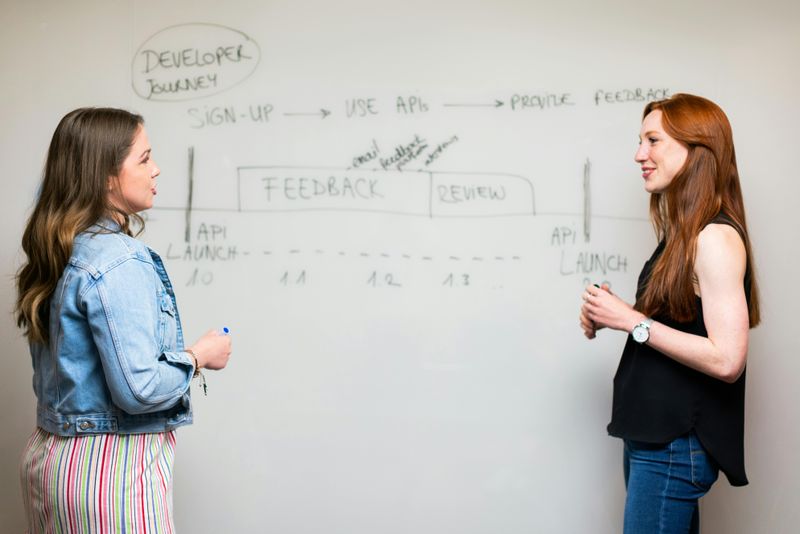Correggere qualcuno senza pestare i piedi o causare imbarazzo richiede una vera finezza. Ci siamo passati tutti: abbiamo ascoltato un amico, un collega o persino un estraneo che sbagliava completamente qualcosa, ma non vogliamo essere la persona che sbotta senza mezzi termini per correggerlo.
La chiave sta nella diplomazia, dove entra in gioco l'arte della sottigliezza e della gentilezza. Ecco le frasi intelligenti che le persone brillanti usano per sottolineare gli errori, mantenendo l'armonia e incoraggiando la crescita nella conversazione.
Queste frasi aiutano a indirizzare delicatamente qualcuno verso la verità senza scatenare difese. Utilizzate questi strumenti di conversazione per migliorare le vostre capacità di comunicazione e costruire relazioni più forti.
1. "Io la vedo un po' diversamente".
Questa frase introduce delicatamente una prospettiva diversa senza negare il punto di vista dell'altra persona. Dicendo: "Io la vedo un po' diversamente", riconoscete la loro opinione e convalidate i loro sentimenti e le loro idee.
Questo approccio apre il dialogo invece di chiuderlo. È un modo per dire che c'è dell'altro nella storia senza sminuire la loro parte.
Immaginate di discutere di un argomento controverso al lavoro. Invece di dire direttamente: "Hai torto", questa frase vi permette di condividere le vostre intuizioni come un nuovo livello da considerare. Implica che la conversazione può beneficiare di più prospettive, favorendo un ambiente collaborativo.
L'uso di questa frase può allentare la tensione, poiché non implica che l'altra persona sia scorretta, ma piuttosto che c'è un'angolazione alternativa da esplorare, che porta a una discussione più ricca e ricca di sfumature. È perfetta per gli scenari lavorativi o anche per le conversazioni casuali in cui è essenziale mantenere il rapporto.
2. "Avete considerato...?"
La frase "Hai considerato...?" è un sottile stimolo a esplorare punti di vista alternativi senza affrontare direttamente le convinzioni di qualcuno. Invita l'altra persona a pensare in modo critico e a rivalutare la propria posizione.
Questo è particolarmente efficace in contesti accademici o di problem solving, dove le idee devono essere messe in discussione e perfezionate.
Per esempio, durante una riunione di team, se qualcuno suggerisce una strategia che presenta evidenti svantaggi, potreste reindirizzare delicatamente la conversazione chiedendo: "Avete considerato i potenziali rischi di questo approccio?".
Questo suggerimento non respinge completamente la loro idea, ma li incoraggia a vedere il quadro più ampio.
Quando si sposta l'attenzione da ciò che è giusto o sbagliato all'esplorazione delle possibilità, si attenua il colpo del disaccordo. Inoltre, vi posiziona come un collaboratore piuttosto che come un avversario, il che può rafforzare le relazioni professionali e personali.
Questa frase è uno strumento prezioso per promuovere discussioni aperte.
3. "È un punto interessante, ma...".
Iniziando con "È un punto interessante, ma..." si riconosce il contributo dell'altra persona e si indirizza delicatamente la conversazione in una direzione diversa. L'elogio iniziale funge da cuscinetto, rendendo meno stridente la successiva correzione.
È un modo efficace per mantenere un dialogo positivo, soprattutto quando l'argomento è delicato o controverso.
Immaginate uno scenario in cui un collega presenta un'analisi errata. Riconoscendo lo sforzo con "È un punto interessante", convalidate il loro lavoro, il che è fondamentale per mantenere il morale e il rispetto.
Seguendolo con un "ma", potete introdurre il vostro punto di vista o evidenziare dettagli trascurati.
Questa frase è un approccio diplomatico che si allinea alla critica costruttiva, rendendo più facile per l'altra persona accettare punti di vista alternativi senza sentirsi attaccata. È preziosa nelle situazioni che richiedono sia empatia che assertività.
4. "Penso che questa prospettiva possa esservi utile".
Offrire una nuova prospettiva come un'utile intuizione piuttosto che come una correzione può essere incredibilmente efficace. Suggerendo: "Penso che questa prospettiva possa esserti utile". si posiziona il punto di vista alternativo come una risorsa piuttosto che una confutazione.
Questa frase è particolarmente utile nei contesti educativi o di mentoring, dove l'obiettivo è la crescita e la comprensione.
Considerate una situazione in cui qualcuno è alle prese con un problema. Invece di sottolineare il suo errore, offrite una nuova prospettiva come potenziale soluzione. Questo metodo rispetta la loro intelligenza e incoraggia un ambiente di apprendimento collaborativo.
Presentare le informazioni come consigli utili piuttosto che come contraddizioni permette di accettare più facilmente le opinioni diverse. Non si tratta più di una questione di giusto o sbagliato, ma di condividere le conoscenze. Questa tecnica migliora la comunicazione concentrandosi sul miglioramento collettivo.
5. "Esploriamo entrambi i lati".
La frase "Esploriamo entrambe le parti" invita alla collaborazione anziché al confronto. Suggerisce uno sforzo congiunto per esaminare tutti gli aspetti di un argomento, promuovendo una comprensione equilibrata e approfondita. È particolarmente efficace nelle discussioni in cui entrambe le parti hanno opinioni forti e diverse.
Immaginate un'accesa discussione con un amico su una questione controversa. Proponendo di esplorare entrambe le parti, non insistete per fargli cambiare idea, ma lo invitate a impegnarsi in un'analisi più approfondita. Questo approccio può stemperare la tensione e portare a conversazioni più produttive.
Inoltre, incoraggia il pensiero critico e l'empatia, poiché a entrambe le parti viene chiesto di considerare il punto di vista dell'altro. Questa frase è uno strumento potente per favorire un dialogo aperto e rispetto reciproco in qualsiasi discussione.
6. "Lo pensavo anch'io".
Ammettendo "Anch'io la pensavo così", si crea un legame immediato di empatia e di esperienza condivisa. Questa frase umanizza la correzione, dimostrando che tutti imparano e si evolvono nel tempo. È un modo gentile per introdurre nuove informazioni senza far sentire l'altra persona ignorante o isolata.
In un contesto professionale, questo può essere utile quando si discute di strategie obsolete o di idee sbagliate comuni. Riconoscendo le proprie idee sbagliate del passato, si offre una visione come un viaggio condiviso verso la comprensione, invece di porsi come autorità ultima.
Questa frase non solo attenua l'impatto della correzione, ma crea anche un legame attraverso la vulnerabilità. Dimostra che l'apprendimento è un processo continuo, incoraggiando un approccio aperto alle nuove idee.
È un modo perfetto per guidare una conversazione verso la verità, mantenendo il rispetto e il cameratismo.
7. "Capisco perché lo pensi".
Riconoscere il punto di vista dell'altro con un "capisco perché la pensi così" convalida il suo ragionamento e mostra rispetto per il suo processo di pensiero. È un modo per affermare la loro logica e allo stesso tempo guidarli delicatamente verso una conclusione diversa.
In una discussione su un argomento complesso, questa frase può fungere da ponte empatico. Permette alla persona di sentirsi ascoltata e rispettata, rendendola più ricettiva alle nuove idee.
Esprimendo comprensione, si riduce la difensività e si apre la porta a ulteriori discussioni. È un modo efficace per mantenere il rapporto e incoraggiare un'esplorazione più sfumata dell'argomento. Questa frase è essenziale per creare un dialogo costruttivo, soprattutto in situazioni emotivamente cariche.
8. "Ecco un altro modo di vederla".
Introdurre un punto di vista alternativo con "Ecco un altro modo di vedere la cosa" è un modo delicato per presentare nuove informazioni. Questa frase suggerisce un cambiamento di prospettiva senza respingere l'idea originale, promuovendo l'apertura mentale e l'esplorazione.
In ambito educativo, questo potrebbe essere usato per offrire agli studenti diverse angolazioni su un argomento, incoraggiando il pensiero critico. È un modo non conflittuale per sfidare le ipotesi e stimolare la curiosità. Proponendo un altro punto di vista, si crea un'opportunità di crescita e comprensione.
Questa frase favorisce un approccio collaborativo alla risoluzione dei problemi e alla discussione, rendendola uno strumento prezioso sia per gli educatori che per i leader. Si tratta di espandere gli orizzonti piuttosto che di correggere gli errori.
9. "Questo è un modo per pensarci".
La frase "Questo è un modo di pensarla" è un gentile riconoscimento del fatto che ci sono più prospettive su una questione. Apre la porta a nuove idee senza mettere direttamente in discussione le convinzioni dell'altra persona.
In uno scenario di mentoring, questa frase può essere usata per incoraggiare il mentee a considerare soluzioni o strategie alternative. Convalida l'approccio attuale e suggerisce sottilmente che potrebbero esserci altre opzioni da esplorare.
Usando questa frase, si mantiene un'atmosfera positiva e aperta alla discussione. È un modo rispettoso per guidare qualcuno verso un pensiero più ampio, essenziale per lo sviluppo personale e professionale. Questo approccio rafforza l'idea che più punti di vista possono coesistere e arricchire la comprensione.
10. "Mi piacerebbe conoscere meglio il suo punto di vista".
Esprimere interesse genuino per il punto di vista dell'altro con "Mi piacerebbe saperne di più sul tuo punto di vista" può aprire la strada a un dialogo aperto. Questa frase non solo dimostra rispetto, ma incoraggia anche l'altra persona ad articolare i propri pensieri in modo più chiaro.
In un contesto di conversazione, questa frase invita a un impegno e a una comprensione più profondi. Trasmette che si apprezza il loro contributo e che si è aperti a saperne di più, il che può portare a discussioni più produttive.
Mostrando curiosità e interesse, si crea uno spazio per l'esplorazione collaborativa delle idee. Questo approccio enfatizza il rispetto reciproco e l'apprendimento, rendendolo uno strumento potente per costruire relazioni più forti e promuovere una comunicazione efficace.
11. "Forse ho capito male, può chiarire?".
La frase "Potrei aver capito male, puoi chiarire?" pone l'interlocutore come aperto all'apprendimento e alla comprensione, piuttosto che correggere immediatamente l'altra persona. È un modo umile di affrontare i potenziali errori senza dare la colpa all'interlocutore.
In situazioni in cui la comunicazione può essere stata poco chiara, questa frase è preziosa. Invita l'interlocutore a spiegare nuovamente il suo punto di vista, il che può portare a nuove intuizioni e a una migliore comprensione dell'argomento.
Chiedendo chiarimenti, non solo si impara di più, ma si dimostra anche di rispettare il loro punto di vista tanto da cercare una comprensione più profonda. Questo approccio favorisce un ambiente collaborativo in cui entrambe le parti si sentono ascoltate e valorizzate.
12. "Ho letto una prospettiva diversa".
Introdurre una nuova idea con "Ho letto una prospettiva diversa" fornisce una fonte di informazione esterna, che può essere meno personale e più incentrata sull'apprendimento condiviso. Questa frase è un modo diplomatico per suggerire che potrebbero esserci altri modi di vedere un argomento.
Nelle discussioni in cui le opinioni variano, citare una prospettiva diversa permette di introdurre nuove idee senza rendere la conversazione conflittuale. Implica che ci sono più informazioni da considerare, il che incoraggia l'apertura mentale.
Questa frase è particolarmente utile nelle discussioni accademiche o intellettuali in cui l'apprendimento e la crescita sono gli obiettivi principali. Aggiunge profondità alla conversazione e promuove una cultura di esplorazione e comprensione.
13. "Guardiamo insieme i fatti".
Proporre un esame congiunto con "Guardiamo insieme i fatti" invita alla collaborazione e alla comprensione condivisa. Questo approccio non mira tanto a dimostrare chi ha ragione, ma piuttosto a cercare la verità come una squadra.
In un contesto professionale, questa frase può essere usata per affrontare discrepanze nei dati o nelle interpretazioni. Proponendo di esaminare i fatti insieme, si favorisce un senso di lavoro di squadra e di condivisione degli obiettivi.
Questo metodo riduce la difensività e incoraggia un'analisi più obiettiva della situazione. È un modo efficace per costruire fiducia e cooperazione, essenziali per una collaborazione e una comunicazione di successo.
14. "Apprezzo il suo punto di vista".
Riconoscere la prospettiva dell'altro con "Apprezzo il tuo punto di vista". mostra rispetto e apprezzamento per il loro contributo. Questa frase crea una base positiva per ulteriori discussioni e potenziali disaccordi.
Nei team, esprimere apprezzamento per i diversi punti di vista può migliorare la collaborazione e il morale. Crea un tono di inclusione e apertura, rendendo più facile l'introduzione di opinioni diverse.
Iniziando con l'apprezzamento, si riduce la difensività e si crea un'atmosfera di rispetto reciproco. Questo approccio incoraggia uno scambio costruttivo di idee, essenziale per un lavoro di squadra efficace e per la costruzione di relazioni.
15. "E se considerassimo questo angolo?".
Introdurre una prospettiva alternativa con "E se considerassimo questo punto di vista?" è un modo creativo per ampliare la discussione. Questa frase implica che ci sono più modi per affrontare un problema, incoraggiando l'apertura mentale e l'esplorazione.
Nelle sessioni di brainstorming, questa frase può stimolare nuove idee e approcci. Suggerisce che la prospettiva attuale non è l'unica, invitando gli altri a pensare fuori dagli schemi.
Proponendo una nuova prospettiva, si creano opportunità di innovazione e crescita. Questa frase è uno strumento prezioso per incoraggiare la creatività e la collaborazione in qualsiasi ambiente.
16. "Possiamo esaminare le prove?"
Proporre una revisione con "Possiamo esaminare le prove?" focalizza la conversazione sulle informazioni oggettive e sull'apprendimento condiviso. Questo approccio prevede la ricerca della verità piuttosto che la vittoria di una discussione.
Nelle discussioni scientifiche o analitiche, l'esame congiunto delle prove può portare a conclusioni più accurate. Sottolinea l'importanza dei fatti e dei dati nel processo decisionale.
Questa frase incoraggia un approccio collaborativo alla risoluzione dei problemi, favorendo un senso di lavoro di squadra e di rispetto reciproco. È un modo efficace per mantenere l'obiettività ed evitare pregiudizi personali nelle discussioni.
17. "C'è un'altra prospettiva da considerare?".
La domanda "C'è un'altra prospettiva da considerare?" apre la strada a più punti di vista, incoraggiando una comprensione più completa dell'argomento. Questa frase invita gli altri a pensare al di là delle loro ipotesi iniziali.
Nelle discussioni di gruppo, porre questa domanda può portare a dialoghi più inclusivi e diversificati. Suggerisce che la prospettiva attuale potrebbe non essere l'unica o quella completa, promuovendo l'apertura mentale.
Considerando altri punti di vista, si promuove una cultura di esplorazione e di apprendimento. Questa frase è un potente strumento per incoraggiare il pensiero critico e la collaborazione, essenziali in qualsiasi contesto di gruppo.
18. "Potrebbe esserci qualcosa di più nella storia?".
La frase "Potrebbe esserci dell'altro nella storia?" suggerisce che potrebbero esserci informazioni aggiuntive che non sono state considerate. Questo approccio incoraggia la curiosità e l'approfondimento dell'argomento.
In contesti investigativi, questa frase può spingere ad approfondire la ricerca e l'analisi. Implica che la comprensione attuale potrebbe essere incompleta, invitando gli altri a cercare un quadro più completo.
Quando suggerite che la storia potrebbe essere più complessa, aprite la porta a nuove intuizioni e possibilità. Questa frase incoraggia un approccio approfondito e aperto alla risoluzione dei problemi e al processo decisionale.
19. "È un'osservazione valida, tuttavia...".
Iniziare con "Questo è un punto valido, tuttavia..." riconosce il contributo dell'altra persona e introduce delicatamente un'idea contrastante. Questa frase bilancia il rispetto con l'assertività, rendendo più facile la discussione di opinioni diverse.
Nelle trattative, questo approccio può mantenere un'atmosfera positiva mentre si affrontano i disaccordi. Dimostra che si apprezza il contributo dell'altra persona, anche se si ha un punto di vista alternativo.
Riconoscendo la validità prima di introdurre la propria prospettiva, si riduce la difensiva e si promuove un dialogo costruttivo. Questa frase è essenziale per mantenere il rispetto e la cooperazione nelle discussioni.
20. "Forse potremmo anche pensarla in questo modo".
Offrire un pensiero alternativo con "Forse potremmo anche pensarla in questo modo" invita gli altri a considerare diverse possibilità. Questa frase è un modo delicato per introdurre nuove idee senza respingere la prospettiva attuale.
Nelle discussioni comunitarie, suggerire punti di vista alternativi può arricchire la conversazione e portare a soluzioni più complete. Implica che ci sono più modi per affrontare un argomento, incoraggiando l'inclusività.
Presentando i nuovi pensieri come aggiuntivi anziché opposti, si favorisce un ambiente collaborativo in cui tutte le idee sono apprezzate. Questo approccio migliora la creatività e la comprensione nei gruppi.
21. "Capisco il suo punto di vista e...".
La frase "Capisco il tuo punto di vista e..." riconosce il punto di vista dell'altra persona e aggiunge il proprio. Questo approccio enfatizza la collaborazione e il rispetto reciproco, rendendo più facile la discussione di opinioni diverse.
In ambito professionale, questa frase può mantenere un'atmosfera positiva e incoraggiare un dialogo aperto. Dimostra che si apprezza il contributo dell'interlocutore, anche se si hanno ulteriori spunti da offrire.
Combinando il riconoscimento con la vostra prospettiva, riducete la difensiva e promuovete uno scambio di idee costruttivo. Questa frase è essenziale per mantenere il rispetto e la cooperazione nelle discussioni.
22. "Prendiamoci un momento per ripensarci".
Il suggerimento "Prendiamoci un momento per riconsiderare" offre una pausa di riflessione e un'analisi ponderata. Questa frase incoraggia un approccio più deliberato al processo decisionale, lasciando il tempo di far emergere nuove intuizioni.
Nei contesti di leadership, questo approccio può portare a decisioni più informate ed equilibrate. Dimostra che si dà importanza a una riflessione approfondita e che si è aperti a rivedere le conclusioni iniziali.
Incoraggiando il ripensamento, si crea uno spazio per la crescita e la comprensione. Questa frase favorisce una cultura di riflessione e di decisioni ponderate, essenziali per una leadership efficace.
23. "Potremmo imparare entrambi da questo".
La frase "Potremmo imparare entrambi da questo" fa sì che la conversazione sia un'esperienza di apprendimento condivisa. Questo approccio enfatizza la collaborazione e la crescita reciproca, rendendo più facile la discussione di opinioni diverse.
In contesti educativi o professionali, questa frase può incoraggiare il dialogo aperto e l'esplorazione di nuove idee. Dimostra che si apprezza l'opportunità di imparare dagli altri, anche quando le prospettive sono diverse.
Quando si inquadra la discussione come un'esperienza di apprendimento reciproco, si riduce la difensività e si promuove uno scambio di idee costruttivo. Questa frase favorisce una cultura di apprendimento continuo e di collaborazione.
24. "Possiamo approfondire questo argomento?".
Invitare a un'ulteriore esplorazione con "Possiamo approfondire questo argomento?" incoraggia un'analisi e una comprensione approfondite. Questa frase sottolinea un approccio più completo alla discussione, alla ricerca di approfondimenti.
In contesti educativi o analitici, questo approccio può portare a conversazioni più ricche e informate. Dimostra che si apprezza una comprensione approfondita e che si è aperti ad approfondire l'argomento.
Incoraggiando un'esplorazione più approfondita, si crea un ambiente collaborativo in cui l'apprendimento e la crescita sono prioritari. Questa frase favorisce una cultura della curiosità e del pensiero critico.
25. "Penso che ci sia più di un modo di vedere la cosa".
La frase "Penso che ci sia più di un modo di vedere questa cosa" incoraggia la considerazione di più prospettive. Questo approccio promuove l'apertura mentale e l'esplorazione, essenziali per una comprensione completa.
In contesti filosofici o riflessivi, questa frase può portare a dialoghi più inclusivi e diversificati. Suggerisce che la prospettiva attuale potrebbe non essere l'unica o quella completa, invitando gli altri a pensare oltre le loro ipotesi iniziali.
Quando si considerano altri punti di vista, si promuove una cultura di esplorazione e apprendimento. Questa frase è un potente strumento per incoraggiare il pensiero critico e la collaborazione, essenziali in qualsiasi contesto di gruppo.
26. "Possiamo ampliare la nostra visione?".
La domanda "Potremmo ampliare la nostra visione?" invita i partecipanti a considerare una gamma più ampia di prospettive e possibilità. Questo approccio incoraggia l'inclusività e l'apertura mentale, promuovendo una comprensione più approfondita dell'argomento.
In contesti collaborativi o strategici, questa frase può portare a soluzioni e decisioni più complete. Implica che ci può essere di più da considerare, incoraggiando un esame più ampio dell'argomento.
Suggerendo una visione più ampia, si creano opportunità di innovazione e crescita. Questa frase favorisce una cultura di inclusione ed esplorazione, essenziale per un lavoro di squadra e un processo decisionale efficaci.
27. "Vediamo se c'è un altro punto di vista".
La frase "Vediamo se c'è un altro punto di vista" apre la porta a prospettive e idee diverse. Questo approccio incoraggia l'esplorazione e la comprensione, essenziali per discussioni significative.
In contesti casuali o formali, questa frase può portare a dialoghi più ricchi e inclusivi. Suggerisce che la comprensione attuale potrebbe essere limitata, invitando gli altri a condividere i loro pensieri.
Esplorare altri punti di vista e promuovere una cultura della curiosità e dell'apprendimento. Questa frase è uno strumento prezioso per incoraggiare l'apertura mentale e la collaborazione, migliorando la qualità delle discussioni e delle relazioni.
28. "È un'idea intrigante: cosa ne pensa di questa prospettiva?".
Questa frase consente di convalidare l'idea dell'interlocutore e di introdurre un punto di vista alternativo. Mantiene la conversazione aperta e collaborativa, dimostrando che rispettate i loro pensieri e che siete ugualmente impegnati a trovare la soluzione migliore.
Nelle discussioni per la risoluzione dei problemi, questo può essere un modo delicato per suggerire di riconsiderare un approccio senza metterlo direttamente in discussione. L'uso del "come ti senti" favorisce il dialogo e la curiosità, portando a uno scambio costruttivo di idee.
Inquadrando il vostro contributo come un'aggiunta piuttosto che come una correzione, creerete uno spazio per l'apprendimento reciproco e l'esplorazione ponderata dell'argomento.
29. "Questo è un modo di vedere la cosa - potrebbe funzionare anche un altro approccio?".
Questa frase riconosce la validità del punto di vista dell'altra persona e suggerisce gentilmente che potrebbero esserci soluzioni alternative. È un modo rispettoso per incoraggiare l'apertura mentale e l'esplorazione senza sminuire il loro contributo.
Nelle discussioni di gruppo o nelle sessioni di brainstorming, questo può ispirare la creatività e l'innovazione, spingendo gli altri a pensare oltre le loro ipotesi iniziali. Dimostra la volontà di collaborare e di esplorare tutte le possibilità.
Proponendo alternative in modo non conflittuale, si favorisce un ambiente in cui vengono accolte idee diverse, che in ultima analisi portano a risultati più solidi.
30. "Non l'avevo mai vista in questo modo".
Riconoscere il punto di vista di un'altra persona può aprire la porta a discussioni più significative. L'uso di questa frase dimostra che apprezzate il loro contributo e siete disposti a prenderlo in considerazione. Inoltre, sottintende che avete una prospettiva diversa senza opporvi direttamente alla loro.
Questo approccio può guidare delicatamente la conversazione verso una visione più equilibrata, incoraggiando entrambe le parti a condividere apertamente i loro pensieri. È un modo per colmare le lacune, rendendo più facile esprimere la propria opinione in un secondo momento della discussione.
Creando un ambiente di rispetto reciproco, questa frase favorisce un'atmosfera di collaborazione in cui entrambe le parti possono imparare e crescere dalle reciproche intuizioni.
31. "È un punto di vista interessante, cosa l'ha portata a questa conclusione?".
Esprimere interesse per i ragionamenti di qualcuno può aprire la strada a una comprensione più profonda. Questa frase mostra rispetto per il loro processo di pensiero e apre il dialogo, consentendovi di acquisire una visione più approfondita del loro punto di vista.
Incoraggia l'altra persona ad approfondire le sue opinioni, il che può rivelare un terreno comune o evidenziare aree che necessitano di ulteriori discussioni. Cercando sinceramente di capire, si crea uno spazio per una conversazione onesta e costruttiva.
Questa espressione non solo disinnesca la potenziale difensività, ma crea anche un rapporto, favorendo un'interazione più coinvolgente e rispettosa.
32. "Esaminiamo insieme le prove".
Proporre un esame congiunto dei fatti può essere un modo neutrale per affrontare le differenze. Questa frase enfatizza un approccio collaborativo, evidenziando che si dà più valore ai fatti che alle opinioni.
Concentrandovi sulle prove, allontanate la discussione dai pregiudizi personali e la orientate verso un'analisi oggettiva. Questo metodo può portare a una comprensione più chiara e alla risoluzione di opinioni diverse.
Una collaborazione di questo tipo non solo rafforza le relazioni, ma incoraggia anche una valutazione equa della situazione, aprendo la strada a un accordo reciproco.

































